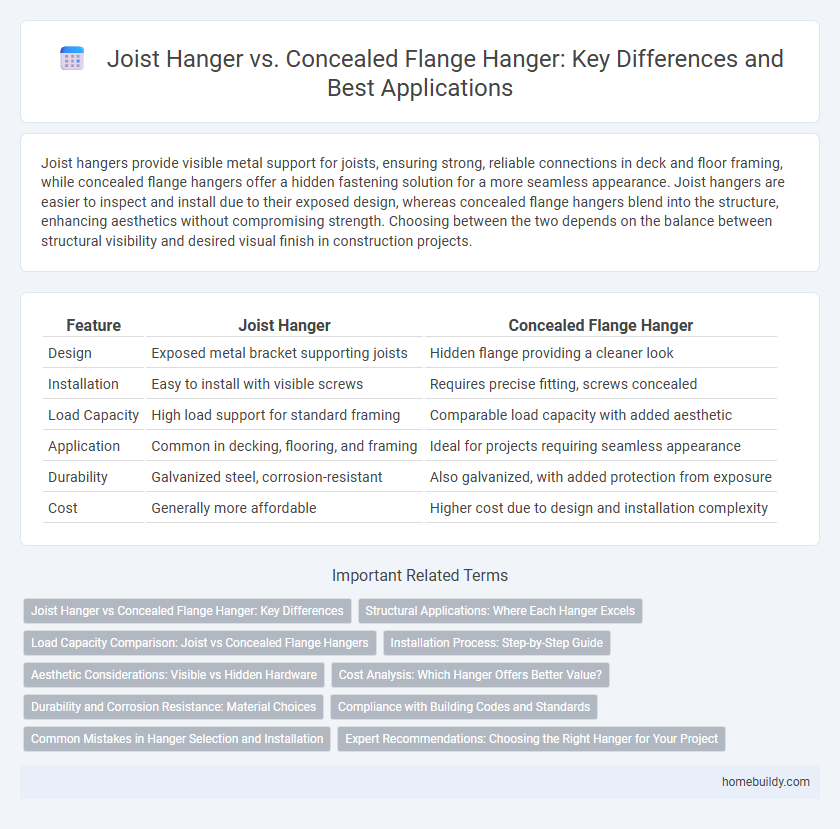Joist hangers provide visible metal support for joists, ensuring strong, reliable connections in deck and floor framing, while concealed flange hangers offer a hidden fastening solution for a more seamless appearance. Joist hangers are easier to inspect and install due to their exposed design, whereas concealed flange hangers blend into the structure, enhancing aesthetics without compromising strength. Choosing between the two depends on the balance between structural visibility and desired visual finish in construction projects.
Table of Comparison
| Feature | Joist Hanger | Concealed Flange Hanger |
|---|---|---|
| Design | Exposed metal bracket supporting joists | Hidden flange providing a cleaner look |
| Installation | Easy to install with visible screws | Requires precise fitting, screws concealed |
| Load Capacity | High load support for standard framing | Comparable load capacity with added aesthetic |
| Application | Common in decking, flooring, and framing | Ideal for projects requiring seamless appearance |
| Durability | Galvanized steel, corrosion-resistant | Also galvanized, with added protection from exposure |
| Cost | Generally more affordable | Higher cost due to design and installation complexity |
Joist Hanger vs Concealed Flange Hanger: Key Differences
Joist hangers feature an open-ended design that supports the end of a joist by wrapping around its sides, ensuring strong load transfer and ease of installation. Concealed flange hangers provide a more discreet appearance by hiding the flange within the framing, offering enhanced aesthetics without compromising structural support. The key differences lie in visibility, installation method, and the specific application requirements for load-bearing and design preferences in construction projects.
Structural Applications: Where Each Hanger Excels
Joist hangers provide superior load distribution for heavy timber framing, making them ideal for exposed structural beams in decks and floor systems. Concealed flange hangers excel in aesthetic applications where a clean, uninterrupted surface is essential, such as in interior ceilings and fine woodworking projects. Structural applications demanding visible strength and easy inspection favor joist hangers, while concealed flange hangers suit areas requiring discreet support without compromising integrity.
Load Capacity Comparison: Joist vs Concealed Flange Hangers
Joist hangers typically offer higher load capacity than concealed flange hangers due to their reinforced design and multiple fastening points, which distribute weight more effectively across the beam and joist. Concealed flange hangers provide a cleaner aesthetic with hidden flanges but often sacrifice some load-bearing strength, making them suitable for lighter loads or residential applications. Structural engineers recommend selecting joist hanger models specifically rated for the required load to ensure safety and compliance with building codes.
Installation Process: Step-by-Step Guide
Joist hangers require securing the hanger to the ledger board and the joist using galvanized nails or screws, ensuring proper alignment and load distribution. Concealed flange hangers involve embedding the flange within the ledger, which may require additional cutting and precise measurements for a seamless fit. Both installation processes emphasize structural integrity but differ in visibility and finish, with concealed flange hangers offering a cleaner appearance at the expense of more intricate installation steps.
Aesthetic Considerations: Visible vs Hidden Hardware
Joist hangers typically feature visible hardware that can affect the overall aesthetic, making them better suited for structural applications where functionality takes precedence. Concealed flange hangers offer a cleaner, more streamlined appearance by hiding the fasteners, enhancing the visual appeal in exposed or decorative woodwork. Choosing between the two depends on whether the project prioritizes structural visibility or seamless integration with the surrounding materials.
Cost Analysis: Which Hanger Offers Better Value?
Joist hangers typically offer a more budget-friendly solution compared to concealed flange hangers, making them ideal for cost-sensitive projects. Although concealed flange hangers provide a cleaner aesthetic and enhanced structural support, their higher material and installation costs can impact overall project budgets. Evaluating the balance between upfront costs and long-term durability is crucial to determining which hanger delivers better value for specific construction needs.
Durability and Corrosion Resistance: Material Choices
Joist hangers typically use galvanized steel known for strong durability and corrosion resistance in various environments. Concealed flange hangers often employ stainless steel or coated metals that provide enhanced protection against rust and moisture, extending the lifespan in outdoor or high-humidity applications. Material choice directly impacts the longevity and structural integrity of both hanger types, with stainless steel offering superior resistance in aggressive conditions.
Compliance with Building Codes and Standards
Joist hangers and concealed flange hangers must both comply with key building codes such as the International Building Code (IBC) and standards from the American Wood Council (AWC). Joist hangers typically meet ASTM A653 standards for steel thickness and corrosion resistance, ensuring reliable load support and safety. Concealed flange hangers require careful selection to comply with fire-resistance ratings and load requirements specified in local codes, making them suitable for projects prioritizing aesthetics without compromising structural integrity.
Common Mistakes in Hanger Selection and Installation
Common mistakes in joist hanger selection include choosing a hanger that lacks sufficient load capacity or using incompatible materials that can cause corrosion or structural failure. In contrast, concealed flange hangers are often misapplied by failing to account for proper flange alignment, leading to inadequate load distribution and potential joist slippage. Proper installation requires verifying hanger size, fastener type, and positioning to ensure optimal structural integrity and longevity.
Expert Recommendations: Choosing the Right Hanger for Your Project
Expert recommendations emphasize selecting the right hanger based on load capacity, material compatibility, and installation environment. Joist hangers provide robust support for exposed connections and are ideal for heavy loads, while concealed flange hangers offer a cleaner aesthetic by hiding hardware, suited for architectural applications. Structural engineers often advise using joist hangers in high-stress areas and concealed flange hangers when maintaining visual appeal is critical.
joist hanger vs concealed flange hanger Infographic

 homebuildy.com
homebuildy.com